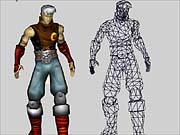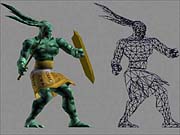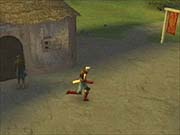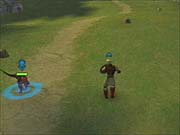The Legend of Alon D'ar Preview
We take a trip to Stormfront Studios to see Ubi Soft's upcoming RPG.
RPG fans who own a PlayStation 2 have been patiently biding their time with the few role-playing games to hit the console since its launch last year. Fortunately, since PS2 development has started to hit its stride, new titles on the horizon look to engage gamers with different takes on the RPG formula. One such title comes from developer Stormfront Studios, whose upcoming PS2 RPG, The Legend of Alon D'ar, aims to offer players a decidedly different experience from that of the more typical RPG. During a recent visit to Stormfront, we got our hands on a build of the game and took it for a test drive to see how things were coming.

When it was shown at E3 nearly two years ago, The Legend of Alon D'ar went by the name "Eternal Blade" and was in very rough form. Little was known about the story, but the company promised big things when asked about the game. Now, two years of development and roughly three publishers later, the game is nearing completion and looks as though it will actually offer a different take on the RPG genre than what's been seen on the PS2 so far.
Senior Producer Sarah Stocker cites the desire to do something different as the main motivator for the team's decision to tell an original story. Without the constraints of a license or a known world, the team was free to let its imagination run wild when designing characters. Written by Christy Marx, a scriptwriting veteran whose portfolio runs the gamut from live-action TV fare such as Babylon 5 to the animated X-Men Evolution series, Alon D'ar's story is set on the world of Chandar. A young warrior named Jarik finds himself marked with a mystical symbol and is sent off on a quest after his village is attacked. Jarik's travels are filled with peril, thanks to the fact that Chandar is a shattered world made up of many floating continents that are home to different races. Jarik's people, the Orin, are a human race inhabiting the foothills. A race of female warriors called the Kemarrans live in the Kemarran Highlands. The Dagani are a race of humanoid amphibians that live in the swamps. Finally, the Sarojins are a race of mystical humanoid lizards that have constructed mystical portals throughout Chandar. Like in all good RPGs, Jarik's quest is one of self-discovery--one that will eventually change his life forever. Over the course of the game, he will encounter and join forces with three other residents of Chandar as he comes to understand the true nature of his quest.

To bring Chandar and its residents to life, Art Director Bill Boyer and his crew set out to create characters that were truly original, not derivative. Once the designs were set, Jarik and the three other lead characters were modeled out of 2,000 polygons. The team's key priorities were to create an organic world that would avoid the stereotypes that most people expect from an RPG and to ensure that the main characters were solid. To that end, the team made a concerted effort to make sure the various creatures you'll encounter in the world match the ecology of the land in which they're found. Once everything was designed and modeled, animation was added to give the various creations, humanoid and otherwise, a distinctive look. For example, small doglike creatures, which are harmless, will graze and move about the land as you go about your business, but if you get too close, they scurry away. A simple AI routine was also created to let birds flock together when in flight. Ambient sound is also being used to provide atmosphere for the various locations. The in-game voices for the various characters should be a pleasant surprise for RPG fans, since they actually sound pretty good. Nothing too groundbreaking to be sure, but little touches like that throughout the game have gone a long way toward making Chandar feel like a living world.
While the character design and art help make The Legend of Alon D'ar's overall "look" seem impressive, the game's graphics engine provides a solid showcase for it by running at a solid 60 frames per second. Producer Adrian Earle and Lead Programmer Mark Danks were pleased at the PS2's performance and noted that the engine pushes roughly 100,000 to 150,000 polygons per frame and features antialiasing, a full particle system, dynamic lighting, and cloth animation, to name just some of the effects being used in the game. The game's graphics engine also allows for large outdoor areas that you'll be able to explore; you'll even be able to look over the end of the world. The frame rate dipped slightly in a few places in the build we played, but the game has yet to be fully optimized, leaving plenty of room for improvement.

Alon D'ar's solid visuals and high frame rate wouldn't mean much if the gameplay were lacking--so Stormfront is trying to make sure that the gameplay is as well thought out as every other aspect of the game. The basics in the game are laid out intuitively. You'll control Jarik from a third-person perspective--movement is handled with the left analog stick, and limited camera control is available through the right. By using the R3 button on the stick, you'll be able to toggle the camera zoom on and off. You'll access your inventory via the square button and interact with other characters and make menu selections with the X button. The right and left shoulder buttons will let you scroll the various pages in your inventory.
Alon D'ar's combat differs from that of most RPGs due to the nearly seamless transition into battle. When you encounter an enemy, a meter appears onscreen, and then the fight begins--which is similar to FFX's combat transition. Battles take place in pseudo real-time (you'll have a second or two to plan your attacks), with a meter indicating how long it will be before you attack again. When you encounter more than one enemy, you'll be able to target a specific opponent with a cursor. If there is more than one person in your party, you'll be able to select his or her attacks and targets as well. One of the game's more interesting features is that a second player can join a game at any time by plugging in another PS2 controller. During combat, each player will have control of at least one character and (if the party is large enough) a maximum of two characters, allowing for cooperative play at any time. This feature also lets the second person drop in or out of a game without any consequences to the main player's save or game in progress.

Another perk is the ability to change a character's affinity (like magic or weapon class) at any point in the game. Because of the game's skill system, its level system differs a bit from the norm. After a battle, you collect gold and proficiency points. Proficiency points function somewhat like experience points do in a traditional RPG--they help characters gain levels. However, when characters go up in level, the only attributes that increase are their health and magic points. It's up to you to decide which attributes to increase by spending the proficiency points. As such, it's possible to train all characters to be proficient with nearly any weapon or magic type if they have enough points stored. It is an interesting system that seems to have potential and has the benefit of providing you freedom in how your party evolves.
So far, The Legend of Alon D'ar looks to be a promising game that will offer you a change of pace from traditional RPGs. While the story seems to be fairly linear, the amount of freedom open to you in the game and the various side quests that can be undertaken seem to make for a meaty challenge. Gamers interested in exploring the land of Chandar can look for the Legend of Alon D'ar this November.
Got a news tip or want to contact us directly? Email news@gamespot.com
Join the conversation